Bulletin – June 2013 Global Economy Developments in Renminbi Internationalisation
- Download the article 277KB
Abstract
The ‘internationalisation’ of the Chinese renminbi (RMB) is proceeding at a measured pace, with a sequence of reforms designed to increase its use in international trade and investment. Over the longer term – as the exchange rate becomes more market determined and as capital account liberalisation progresses – the RMB has the potential to become a major global currency. This article builds on the work of Cockerell and Shoory (2012) by describing developments in the onshore and offshore RMB markets, and the linkages between them, over the past year. In light of China's position as Australia's largest trading partner, the article also discusses the implications of these developments for Australian firms, drawing on the results of a survey conducted for the inaugural Australia-Hong Kong RMB Trade and Investment Dialogue in April 2013.
Introduction
The Chinese economy has experienced rapid growth over the past decade, underpinned by a range of reforms that have seen the economy become more market oriented (see, for example, Sadeghian, White and D'Arcy (2013)). These reforms have included a gradual move towards a more market-determined exchange rate and incremental liberalisation of the capital account. Efforts to ‘internationalise’ the RMB through promoting its use as an invoicing currency for international trade and cross-border financial transactions have been an important aspect of managing this transition.
As China moves towards a more market-determined exchange rate regime, Chinese firms engaging in trade and financial transactions with the rest of the world will increasingly need to find ways to manage their foreign currency risk. This could be done through hedging, but local currency denomination of trade and financial transactions offers a simpler – and potentially less costly – alternative, particularly for small and medium-sized enterprises. Reforms aimed at increasing the use of the RMB in international trade and financial transactions serve to transfer the associated foreign currency risk to the foreign counterparties of those transactions that, at least at present, may be better able to manage it.
The increased use of RMB in trade and financial transactions between Chinese residents and non-residents can be thought of as initial steps in the longer-term process of internationalising the RMB.[1] The scope for the RMB to be used in international trade transactions is already significant: China accounts for around 9 per cent of global trade in goods and services, which is second only to the United States, which accounts for around 12 per cent (Graph 1). But there also appears to be scope for further growth in RMB-denominated cross-border financial transactions over time, with China currently accounting for around 6 per cent of gross global capital flows (of which a large portion is in the form of foreign direct investment), compared with around 17 per cent for the United States. From an Australian perspective, these developments are particularly relevant given the very strong trade linkages between Australia and China, as well as the potential for deepening financial linkages (Lowe 2013).
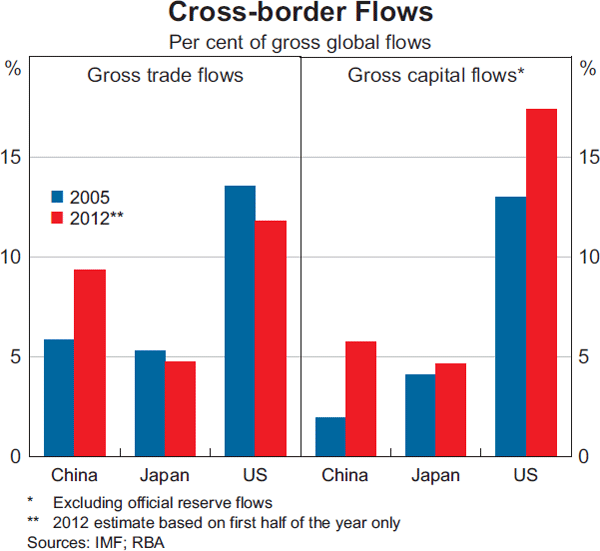
The extent to which the RMB is used in a broader range of international financial transactions, including in transactions between non-residents, will depend crucially on how the broader capital account liberalisation process unfolds. As the experience of many other countries (including Australia) attests, this is not without its challenges.[2] Nevertheless, the RMB clearly has the potential to become a major global currency over the longer term.
The Structure of Renminbi Foreign Exchange Markets
As discussed in detail in Cockerell and Shoory (2012), China's process of exchange rate reform and capital account liberalisation has resulted in the development of two markets for the RMB, which are separated by a set of regulations governing flows between them. Although there is only one Chinese currency, the onshore market in Mainland China is partly segregated from the offshore market, which is centred in Hong Kong. This gives rise to different RMB exchange rates in the onshore market (denoted CNY) and the offshore market (denoted CNH in Hong Kong).[3] While the differences tend to be minor, the two exchange rates have diverged on occasion.[4]
The onshore market
In the onshore market, the RMB has traded under a managed floating exchange rate regime since mid 2005. The China Foreign Exchange Trade System (CFETS), authorised by the People's Bank of China (PBC), sets the central parity rate (or ‘fixing rate’) for the RMB against the US dollar on a daily basis, with the exchange rate allowed to fluctuate within defined bands around this fixing rate.[5] Since mid 2005, the RMB has appreciated by 35 per cent against the US dollar and by 38 per cent in real effective terms (Graph 2). In April 2012, the PBC widened the RMB's daily trading band against the US dollar from +/–0.5 per cent to +/–1 per cent around its daily fixing rate. The RMB has remained in the upper part of this trading band since late 2012. More recently, the Chinese authorities have indicated that the daily trading band could be widened further, citing a desire to move towards a more market-determined rate, including by increasing the flexibility of the exchange rate in both directions.
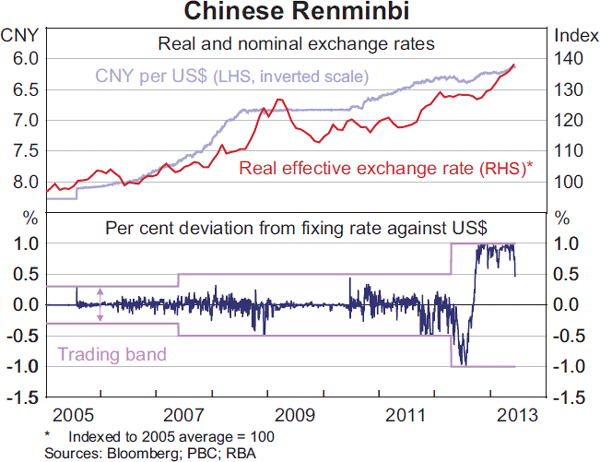
The onshore foreign exchange market has a two-tier structure, comprising the retail foreign exchange market between banks and their customers, and the interbank foreign exchange market. Trading in the interbank foreign exchange market is authorised by the PBC to take place through CFETS, which operates a trading platform that allows approved participants to trade in the interbank foreign exchange market, as well as in the interbank RMB lending and bond markets. Nine currencies are currently permitted to be traded against the RMB through CFETS, as well as nine other foreign currency pairs.[6]
For RMB currency pairs, spot foreign exchange (FX), FX forwards, FX swaps, cross-currency swaps and currency options are all able to be traded through CFETS, with institutions requiring separate approval to trade in each instrument (although not all instruments are available for all pairs). Turnover is largest in the spot market, although there is also sizeable turnover in FX swaps (Table 1).[7] The majority of trading in the RMB spot market currently occurs in the USD/CNY pair, while turnover in RMB FX swaps and FX forwards is almost exclusively in USD/CNY; however, this could change as the market develops further.
| Jul–Dec 2012 | Jan–May 2013 | |||
|---|---|---|---|---|
| All CNY(b) pairs |
Of which: USD/CNY |
All CNY(b) pairs |
Of which: USD/CNY |
|
| Spot | 272 | 250 | 317 | 292 |
| FX swaps | 230 | 230 | 249 | 249 |
| FX forwards | 4 | 4 | 1 | 1 |
|
(a) Excludes turnover in foreign currency pairs Source: CFETS |
||||
CFETS publishes the fixing rate for the nine currencies that are currently traded against the RMB before the start of each trading day. However, of these nine currencies, only the US dollar, Japanese yen, Malaysian ringgit, Russian rouble and, most recently, the Australian dollar, are permitted to be traded ‘directly’ against the RMB in the onshore market without the use of an intermediate third currency.
Direct trading between the Australian dollar and the RMB commenced on 10 April 2013, with quotes for the prevailing AUD/CNY exchange rate in the onshore market provided by licensed market makers. Direct trading of the Australian dollar against the (offshore) RMB is also possible in the Australian foreign exchange market, and all licensed foreign exchange dealers are able to assume a market maker function without the need for formal regulatory approval. In time, direct trading between the Australian dollar and the RMB is likely to facilitate greater use of the RMB as an invoicing currency for bilateral trade and investment between Australia and China, including through potentially reducing the costs of currency conversion as market liquidity increases. In turn, the increased use of RMB in Australia–China trade and investment transactions is likely to create more demand for direct trading between the two currencies. Since direct trading commenced, trading between the Australian dollar and the RMB in the onshore spot market has increased substantially, with turnover rising from the equivalent of US$324 million in March 2013 to US$3.1 billion in May 2013.
The offshore market
The offshore RMB market has developed rapidly over recent years, facilitated in large part by the growth in RMB trade settlement, which is the main channel through which RMB is permitted to cross the border from Mainland China (discussed in more detail below). A number of reforms designed to liberalise the Chinese capital account have also supported the development of the offshore RMB market by expanding the range of channels through which offshore investors can direct funds obtained offshore back into Mainland China (also discussed below). The RMB is fully convertible within the offshore market, with RMB-denominated transactions largely unrestricted and participants able to access a range of RMB-denominated funding and investment products.[8]
Although the onshore and offshore markets remain distinct, arbitrage (for example, via trade flows between affiliated companies with operations in both Mainland China and Hong Kong) means that the onshore and offshore exchange rates tend to converge, notwithstanding some temporary periods of divergence (Graph 3).
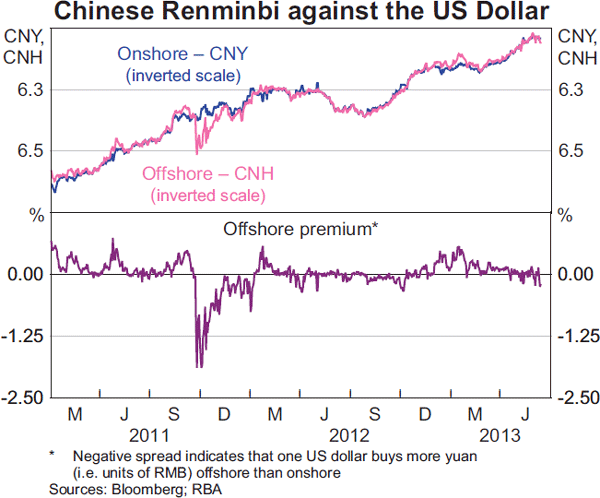
RMB accumulated in the offshore market has been concentrated in four geographical locations known as ‘RMB centres’: Hong Kong (which is by far the largest), Macau, Singapore and Taiwan. These centres are characterised by a designated RMB ‘clearing bank’, which has an account with the PBC and is directly connected to the interbank market in Mainland China via the China National Advanced Payment System (CNAPS). RMB clearing banks are authorised to buy and sell RMB in the onshore market on behalf of offshore customers (subject to a quota), provided that the funds are used for a purpose approved by both the PBC and the authorities in the offshore centre.[9]
A number of other financial centres, including London and Paris, have established what is commonly referred to as an RMB ‘hub’, with these markets reporting RMB deposits of around RMB14 billion and RMB10 billion, respectively, in 2012. These hubs do not have a designated RMB clearing bank and instead rely on other offshore RMB centres to obtain RMB liquidity for their local interbank markets. Sydney can be thought of as an emerging RMB hub, with market support for efforts to increase the use of the RMB for trade and financial transactions. A joint research project funded by the Centre for International Finance and Regulation and the Shanghai University of Finance and Economics will examine the issues around Australia becoming an RMB hub in greater detail.[10]
Developments in RMB Trade Settlement and Investment
The RMB trade settlement scheme is the main channel through which RMB has been able to flow between Mainland China and the offshore RMB market. Since the expansion of the scheme in June 2010, data from the PBC show that RMB-denominated trade settlement has grown substantially, accounting for 15 per cent of China's total foreign trade in the March quarter 2013 (although in 2012 more than half of this was with Hong Kong) (Graph 4). Despite substantial growth in the value of China's trade settled in RMB, Australian Bureau of Statistics data on the currencies used to invoice Australian merchandise trade show that the take-up of RMB trade settlement by importers and exporters is still relatively low. Some of the reasons for this are discussed below.
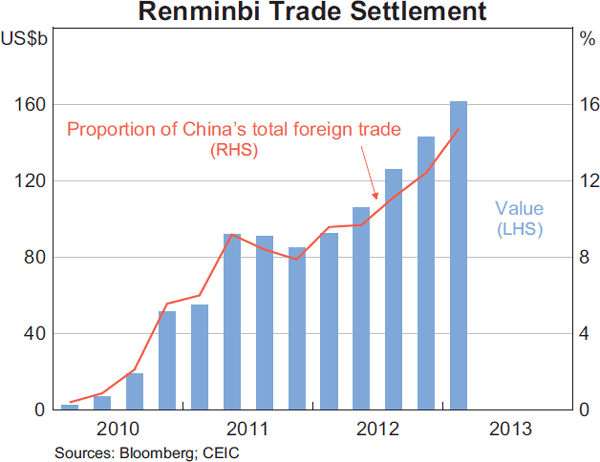
The PBC has sought to promote RMB trade settlement by signing bilateral local currency swap agreements with 19 central banks – including the RBA – with a key objective being to provide market participants with confidence that liquidity in the offshore RMB market will be sufficient to meet RMB-denominated payment obligations. Activation of these agreements results in the PBC depositing RMB into the foreign central bank's account at the PBC in exchange for the foreign central bank depositing its local currency into the PBC's account at the foreign central bank. These RMB funds can then be on-lent to commercial banks by the foreign central bank to finance trade – for example, to provide an importer of Chinese goods with RMB to pay its Chinese counterparty.[11] To date, the PBC's swap lines with the Hong Kong, Korean and Singaporean central banks – which are also the three largest facilities – have all been used by local commercial banks to some degree (Graph 5). Under the RBA's swap agreement (which is the fourth largest), RMB will be made available to commercial banks at the Shanghai Interbank Offered Rate (SHIBOR) plus a margin of 25 basis points. The pricing of the RBA facility is designed to ensure that it is only used as a ‘backstop’; that is, it is intended to only be an attractive source of RMB funding if liquidity in the offshore market is strained relative to the onshore market.
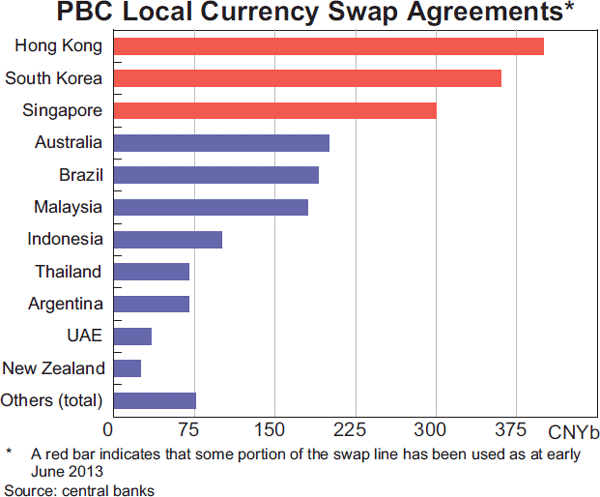
The growth in the RMB trade settlement scheme – and the associated outflow of RMB from Mainland China – has seen the offshore RMB market develop rapidly. RMB deposits in Hong Kong grew substantially through the second half of 2010 and 2011 and now account for 20 per cent of all foreign currency deposits in Hong Kong, compared with 4 per cent in July 2010 (Graph 6). Although the stock of RMB deposits has plateaued somewhat since mid 2011, the Hong Kong Monetary Authority (HKMA) has reported that the stock of RMB certificates of deposit (CDs) increased substantially from around RMB6 billion (equivalent to around US$1 billion) at the end of 2010 to around RMB127 billion (equivalent to around US$20 billion) at the end of February 2013, suggesting that the slower growth in deposits is also partly due to the development of alternative investment products in the offshore market.[12]
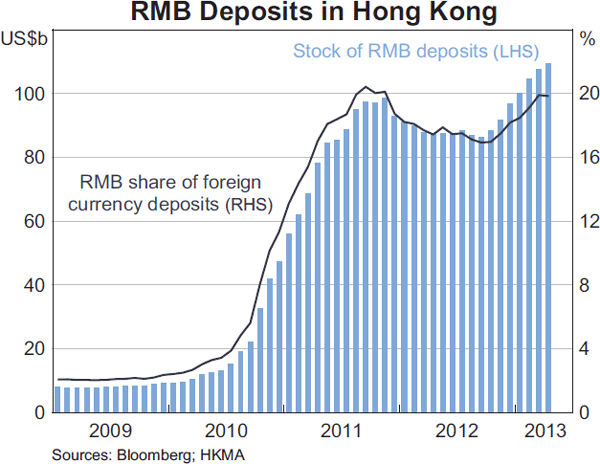
Issuance of offshore RMB-denominated bonds, which offer an alternative investment to deposits for holders of offshore RMB, has also grown strongly in the past two years, albeit from a very low base (Graph 7). Approximately US$18 billion of offshore RMB-denominated bonds were issued in 2012 and the total outstanding value as at May 2013 was the equivalent of around US$50 billion. However, this represents a very small share of global bond issuance, suggesting that there is considerable scope for the market to develop further. This is not only true in terms of the overall size of the market, but also in terms of its breadth. For example, the majority of issuers have been Chinese and a large share of non-resident issuers have been from Hong Kong, although this is changing. To date, most of the activity in the offshore RMB-denominated bond market has been in the primary market, with secondary market activity reported to have been relatively subdued.
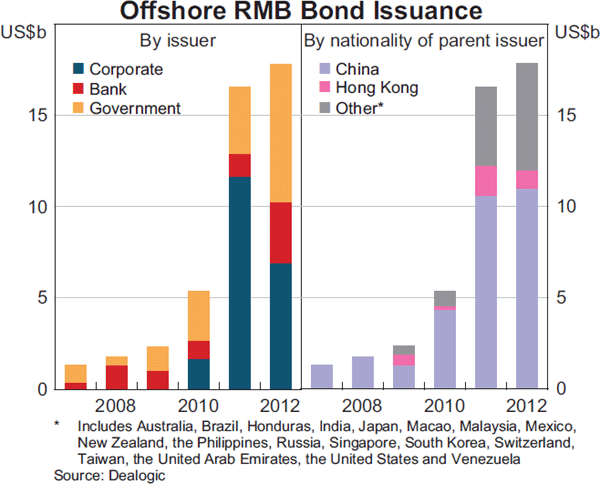
Hong Kong authorities recently announced plans to introduce a CNH Hong Kong Interbank Offered Rate (HIBOR) fixing, which should further support development of the offshore RMB-denominated bond market by providing a benchmark for pricing floating rate bonds. The introduction of a CNH HIBOR curve should also support the development of a number of other RMB-denominated offshore products, including floating rate loan facilities and interest rate derivatives. While offshore RMB-denominated bonds have to date been issued almost entirely in Hong Kong (known as ‘dim sum’ bonds), there have been several issues of RMB-denominated bonds in London since early 2012, and more recently in Taiwan and Singapore.
While trade in goods and services remains the main vehicle for cross-border RMB flows, the partial easing of restrictions on capital flows to and from China has also supported growth in the offshore RMB market (the key changes over the past year are set out in Appendix A). These policy developments have typically been implemented with the use of pilot programs, which are gradually expanded as authorities gain confidence in the arrangements.[13] Over time, as capital account restrictions are relaxed further, participants in the offshore market may be presented with further opportunities to invest RMB funds obtained offshore in Mainland China.
The RMB Qualified Foreign Institutional Investor (RQFII) scheme, which allows approved Hong Kong-based financial entities to invest RMB obtained in the offshore market in specified onshore financial assets, is a key channel through which RMB can flow to Mainland China in the form of private cross-border investment. In March this year, new rules governing the RQFII scheme were announced, expanding both the range of financial institutions that are allowed to access the scheme and the type of securities in which these institutions can invest. The scheme now covers Hong Kong subsidiaries of Chinese funds management companies, securities companies, banks and insurers, as well as other Hong Kong-based financial institutions. Approved investors can invest in individual equities, collective investment vehicles, interbank bonds and equity index futures; however, caps on foreign ownership of equities apply.[14]
RQFII quotas are allocated to individual institutions up to an aggregate limit. Allocated RQFII quotas reached their initial aggregate limit of RMB70 billion (equivalent to around US$11 billion) in January 2013, before this limit was expanded to RMB270 billion (equivalent to around US$43 billion) (Graph 8). In April and May 2013, additional quotas were issued, taking allocated RQFII quotas to RMB92 billion (equivalent to around US$15 billion), though this is still well below the expanded limit.
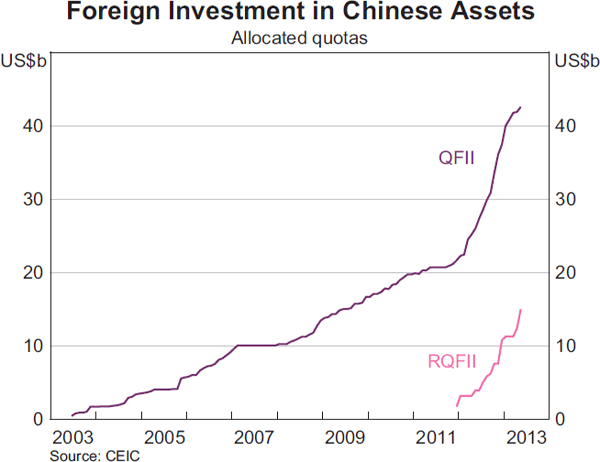
The RQFII scheme is the counterpart to the much larger Qualified Foreign Institutional Investor (or QFII) scheme, which allows approved institutions to use foreign currency to invest in approved RMB-denominated assets in onshore markets. In December 2012, the Chinese authorities removed the upper limit on QFII investments for central banks, sovereign wealth funds and state-owned investment vehicles, with six central banks now registered under the QFII scheme. The central banks of Hong Kong, Korea, Malaysia, Norway, Singapore and Thailand have a combined quota of around US$3.1 billion.
The China Interbank Bond Market (CIBM) program is a second channel through which offshore RMB can be invested in Mainland China. The CIBM scheme, which is operated and regulated by the PBC, provides approved investors with access to the Chinese interbank bond market. A number of central banks are reported to be participants in the CIBM scheme (in some cases in addition to the QFII scheme) including those from Austria, Hong Kong, Indonesia, Japan, Korea, South Africa and Thailand.[15] As announced recently, the RBA's current intention is to invest around 5 per cent of its net foreign currency reserves in RMB: this will take place under the CIBM scheme. In addition to providing scope for portfolio diversification benefits, the decision reflects the strengthening financial ties between Australia and China and should help to increase the RBA's understanding of Chinese financial markets through establishing relationships with local market participants.
RMB Internationalisation and Australia
Australia's strong trade linkages with China mean that the progress towards a more internationalised RMB has important implications for Australian firms. As Australia's financial linkages with China develop over time, the RMB could also be expected to feature more prominently in cross-border capital flows. Both the introduction of direct trading between the Australian dollar and the RMB and the RBA's swap agreement with the PBC go some way towards facilitating this; however, private sector involvement will also be important if the Australian corporate and financial sectors are to be well prepared for these changes.
Against this background, the inaugural Australia-Hong Kong RMB Trade and Investment Dialogue (the Dialogue) was jointly hosted by the Australian Treasury, the HKMA and the RBA in Sydney on 12 April 2013. The aim of the Dialogue was to bring together senior banking and business leaders to raise awareness in the Australian private sector of RMB business opportunities, and to build closer collaboration between the Hong Kong and Australian banking sectors on the development of the offshore RMB market.
A key input to the Dialogue was a survey of firms' attitudes towards RMB trade settlement and investment, which was designed and coordinated by the RBA but conducted by a number of commercial banks. The survey covered 47 firms with Australian operations, each with an importing and/or exporting relationship with China, including firms in the resources, manufacturing and services sectors. The survey indicated that although the take-up of RMB trade settlement in Australia has been limited to date, around 60 per cent of surveyed firms expected their use of RMB trade settlement to increase in the future. However, these firms' interest in RMB investment and the offshore market was less well developed.
Based on the survey, Australian firms identified three key advantages to settling more of their trade with China in RMB (Graph 9). The first was the ability to negotiate improved trade terms with their Chinese counterparts, in particular by eliminating the foreign exchange risk margin that Chinese businesses currently price into foreign currency-denominated trade contracts. The second was related to their recognition that Chinese firms may soon begin to request greater use of RMB trade settlement, and that having the capacity to accommodate these requests could help to establish better trading relationships. The third advantage, which was most evident for firms with some experience with RMB trade settlement, was that settling trade in RMB could improve their ability to hedge their foreign currency exposure.
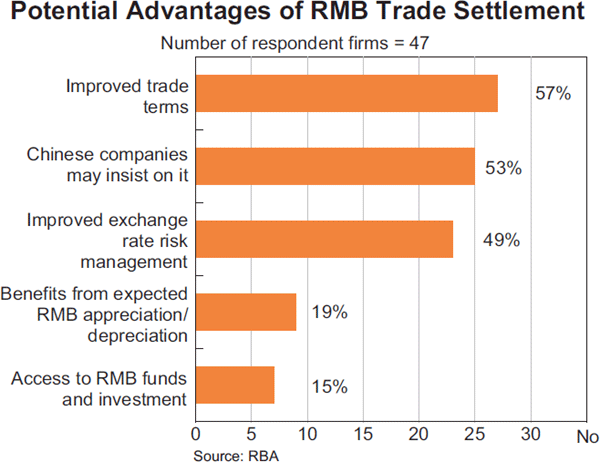
However, the survey respondents also cited several potential impediments to the RMB trade settlement process. In particular, more than half of respondents cited shortcomings in the availability of instruments allowing them to hedge their RMB currency risk. In contrast to firms that identified improved exchange rate risk management as a potential advantage, inadequate access to hedging facilities was most commonly cited among those firms that had not yet undertaken any RMB trade settlement. This apparent inconsistency could potentially be explained if those firms that had undertaken RMB trade settlement had done so to create a ‘natural’ hedge (for example, an exporter with RMB-denominated payment obligations). Around half of firms also noted that unfamiliarity or uncertainty around the RMB trade settlement process was a significant deterrent, and a sizeable proportion also cited administrative difficulties and concerns regarding payment delays and rejections. To this end, a significant outcome of the Dialogue was the establishment of a working group led by representatives from the Australian and Hong Kong banking sectors that will investigate these issues more closely (see ABA (2013)). Raising these issues with the Chinese authorities should also be beneficial.
In relation to RMB trade settlement and the offshore market, the survey indicated that around 75 per cent of firms (all of which currently trade with China) did not currently use offshore RMB products. This is consistent with the relatively limited uptake of RMB trade settlement by Australian firms and the fact that the majority of offshore RMB financial market activity to date has been centred in Hong Kong. Those Australian firms that did use offshore RMB products primarily used such products for RMB trade settlement purposes – predominantly deposits – with Australian firms' appetite for issuing offshore RMB-denominated bonds appearing limited at this stage. However, as RMB trade settlement between Australia and China develops, this could naturally support the increased use of the offshore RMB market by firms with Australian operations. Similarly, as the offshore market develops further, firms may also be more willing to settle trade in RMB.
The Future of RMB Internationalisation
Increasing the use of the RMB in international trade transactions has been a key focus of reforms undertaken so far. To date, the majority of RMB trade settlement has taken place between China and its near neighbours (predominantly Hong Kong), but given that China has important trading relationships with a range of other countries – including Australia – there is substantial scope for further growth, particularly as impediments to the trade settlement process are addressed over time.
The development of the offshore market, which has in turn been largely facilitated by the growth in RMB trade settlement, has gone some way towards increasing the RMB's use as an international investment currency, although progress on this front is at a relatively early stage. In part, this reflects the gradual pace at which restrictions on cross-border capital flows between Mainland China and the offshore market have been eased to date, although the Chinese State Council's recent announcement that it will set out a plan later this year for capital account convertibility indicates a commitment to take further steps.
Some central banks have either started to invest in Chinese assets or have indicated that they plan to, with these decisions likely to have been made for a number of reasons, including to diversify their portfolios. Notwithstanding this growing interest from central banks, RMB assets do not currently satisfy the International Monetary Fund (IMF) definition of ‘official reserve assets’. This is because the RMB is not fully convertible and is therefore not sufficiently liquid to satisfy the requirement for these assets to be ‘readily available’ for ‘meeting balance of payments financing needs, for intervention in exchange markets to affect the currency exchange rate, and for other related purposes’ (IMF 2009, p 111). However, as capital account liberalisation progresses and Chinese financial markets deepen, the RMB is likely to become a major reserve currency.
Appendix A
| Jun 2012 | Outward flows | The State Administration of Foreign Exchange (SAFE) allows Chinese companies to obtain foreign currency loans from banks in Mainland China to fund the operations of their offshore affiliates. |
|---|---|---|
| Jul 2012 | Inward flows | The China Securities Regulatory Commission (CSRC) relaxes eligibility requirements for Qualified Foreign Institutional Investors (QFIIs) and expands the range of authorised investment products under the QFII scheme. |
| Jul 2012 | Inward flows | The State Administration of Taxation implements rules that have the effect of reducing withholding tax obligations for foreign investors from countries that have a double taxation agreement with China. |
| Dec 2012 | Inward flows | Authorities abolish individual QFII quotas for central banks and sovereign wealth funds. |
| Jan 2013 | Inward flows | The first cross-border RMB-denominated loans to companies registered in the Qianhai pilot zone (Mainland China) are approved. |
| Mar 2013 | Inward flows | The CSRC releases revised regulations for the RMB Qualified Foreign Institutional Investor (RQFII) scheme, expanding the scope of approved investments and the range of investors that can access the scheme. The aggregate RQFII quota is formally increased from RMB70 billion to RMB270 billion. |
| Mar 2013 | Inward flows | QFII rules are relaxed to allow all approved QFIIs to purchase bonds in the interbank market. |
| May 2013 | Inward flows | The PBC releases guidelines on the implementation of the RQFII scheme, detailing the requirements needed to issue quotas. |
| May 2013 | Inward flows | SAFE simplifies regulations covering inward foreign direct investment. |
|
Sources: various official sources, media and market reports |
||
Footnotes
The authors are from International Department. [*]
A useful definition of an ‘international’ currency is provided by Kenen (2011, p 9): ‘An international currency is one that is used and held beyond the borders of the issuing country, not merely for transactions with that country's residents, but also, and importantly, for transactions between non-residents.’ [1]
See, for example, Eichengreen (2013). Lowe (2013) discusses some of these challenges in the Australian context. [2]
The renminbi (RMB) is the name of the Chinese currency, while the term ‘yuan’ refers to the units of the currency. [3]
RMB in Taiwan is denoted CNT, although CNT quotes are not generally available publicly. As the CNT market develops, arbitrage is likely to ensure that the CNT rate is near-identical to the CNH rate, as there are no specific restrictions on flows of offshore RMB between Hong Kong and Taiwan (or any other offshore location). [4]
While the market focus is on the USD/CNY rate, CFETS also sets a daily fixing rate for the RMB against eight other currencies (discussed below). [5]
The US dollar, euro, Japanese yen, Hong Kong dollar, British pound sterling, Malaysian ringgit, Russian rouble, Australian dollar and Canadian dollar can all be traded against the RMB on CFETS. The Thai baht can also be traded against the RMB, but only in the province of Yunnan. The nine permitted foreign currency pairs are: AUD/USD, EUR/JPY, EUR/USD, GBP/USD, USD/CAD, USD/CHF, USD/HKD, USD/JPY and USD/SGD. [6]
Around 375 Chinese and foreign institutions are currently authorised to trade RMB currency pairs in the spot market, while the RMB FX forwards, FX swaps and cross-currency swaps markets each have around 80 authorised institutions and the RMB options market has around 35 authorised institutions. [7]
RMB-denominated products in the offshore market include deposits, certificates of deposit, loans, trade finance, FX futures and forwards, non-deliverable forwards, FX options, bonds, exchange-traded funds, real estate investment trusts, commodity-linked products and insurance products. [8]
There are currently four RMB clearing banks – Bank of China (Hong Kong), Bank of China (Macau), Bank of China (Taipei) and Industrial and Commercial Bank of China (Singapore). The RMB clearing banks in Hong Kong and Macau can also provide some services for personal RMB business. For a detailed discussion of how RMB can be transferred between Mainland China and the offshore market, see Cockerell and Shoory (2012). [9]
This project will be overseen by a Steering Committee consisting of representatives from these two organisations, as well as the Reserve Bank of Australia and the Australian Treasury. [10]
The RBA swap agreement with the PBC could also in principle be used to support financial flows between Australia and China – for example, to enable an Australian bank (and/or its clients) to fulfil an RMB-denominated financial obligation. [11]
Figures on RMB-denominated CDs are as reported by the HKMA in various publications. [12]
For a detailed discussion of regulatory changes prior to June 2012, see Cockerell and Shoory (2012). [13]
In addition to RQFII, which relates to portfolio investment flows, a further pilot scheme relating to cross-border banking flows is also underway. The scheme, which remains limited in scope, allows authorised Hong Kong-based financial institutions to provide RMB loans to entities in Mainland China, specifically for construction and development in the Qianhai region of the city of Shenzhen. [14]
Note that central banks, like all investors, are currently free to invest in the offshore CNH market with no restrictions. [15]
References
ABA (Australian Bankers' Association) (2013), ‘Renminbi Trade and Investment Dialogue’, Media Release, 12 April.
Cockerell L and M Shoory (2012), ‘Internationalising the Renminbi’, RBA Bulletin, June, pp 77–89.
Eichengreen B (2013), ‘ADB Distinguished Lecture – Renminbi Internationalization: Tempest in a Teapot?’, Asian Development Review, 30(1), pp 148–164.
IMF (International Monetary Fund) (2009), Balance of Payments and International Investment Position Manual, 6th Edition, IMF, Washington DC.
Kenen P (2011), ‘Currency Internationalisation: An Overview’, in Currency Internationalisation: Lessons from the Global Financial Crisis and Prospects for the Future in Asia and the Pacific, Proceedings of a Joint Conference organised by the BIS and the Bank of Korea in Seoul on 19–20 March 2009, Bank for International Settlements, Basel, pp 9–18.
Lowe P (2013), ‘The Journey of Financial Reform’, Address to the Australian Chamber of Commerce in Shanghai, Shanghai, 24 April. Available at <http://www.rba.gov.au/speeches/2013/sp-dg-240413.html>.
Sadeghian D, G White and P D'Arcy (2013), ‘Macroeconomic Management in China’, RBA Bulletin, June, pp 11–20.